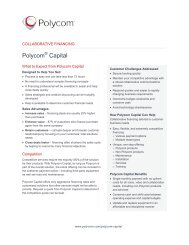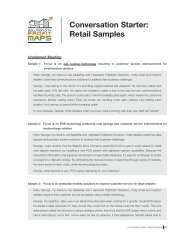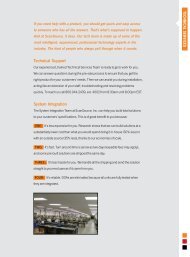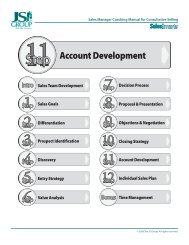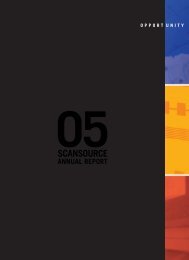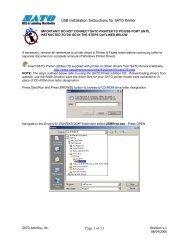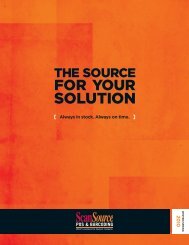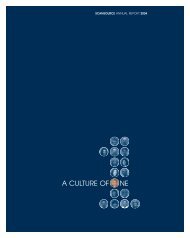Datalogic - ScanSource
Datalogic - ScanSource
Datalogic - ScanSource
You also want an ePaper? Increase the reach of your titles
YUMPU automatically turns print PDFs into web optimized ePapers that Google loves.
Why Change Now?<br />
The GS1 standard for marking trade items, centered around EAN/UPC bar codes, has been evolving for over 30 years.<br />
As described below, there are several retail application systems that worked well ten or twenty years ago, but which<br />
are no longer robust enough to meet today’s business needs. After extensive research and discussion, a GS1-led task<br />
force of business leaders from both retailing and manufacturing companies concluded that it is time for the industry<br />
to take this major step. The adoption of GS1 DataBar TM builds the foundation for addressing many limitations with<br />
current retail systems.<br />
In the following list of applications, only the first is mandated by the GS1 DataBar TM 2010 Sunrise. The adoption of GS1<br />
DataBar TM will enable future standards updates for the remaining applications.<br />
Small Packaged Trade Items<br />
• Problem: It is difficult to place a bar code that is easily<br />
readable on very small items. The EAN-8 and UPC-E<br />
bar codes are intentionally smaller and intended for<br />
marking small items, but there are a limited number of<br />
values possible with only eight digits. This forces many<br />
manufacturers to use very truncated forms of EAN-13<br />
and UPC-A bar codes, which are difficult for point-ofsale<br />
scanners to read.<br />
TM<br />
• Solution: GS1 DataBar is capable of encoding a full<br />
GTIN in about half the space required by EAN-13 and<br />
UPC-A bar codes. Starting in 2010 manufacturers are<br />
enabled and expected to switch to GS1 DataBar TM for<br />
marking many of their products, small and large.<br />
Fresh Produce<br />
• Problem: With increased consumer interest in an<br />
expanding variety of fresh produce, it is increasingly<br />
important that such products be unambiguously<br />
identified. Stickers with Price Look-up (PLU) numbers help,<br />
but there aren’t enough PLU values to go around, and<br />
PLU numbers don’t identify the source of the produce.<br />
TM<br />
• Solution: GS1 DataBar codes can be printed to fit on a produce sticker. A full GTIN is encoded, which<br />
means the product type can be specified unambiguously, and the supplier uniquely identified.<br />
Variable-Measure Fresh Foods<br />
• Problem: The existing Number System 2 UPC-A bar codes used to mark variable weight packages (such as<br />
meat and deli) provide the price, but suffer the same problems seen in fresh produce – neither the precise<br />
product type nor the manufacturer can be captured in the bar code.<br />
TM<br />
• Solution: The GS1 DataBar family includes bar codes that can encode much more than just a GTIN. For<br />
variable-measure foods, for example, the GS1 DataBar TM could encode a GTIN, the weight, the price, and<br />
a sell-by date. Now the full product and manufacturer identification are provided, as well as additional<br />
essential information that will support compliance with the expected FDA requirements for food tracking<br />
and traceability in the grocery retail sector.<br />
Page – 2<br />
A White Paper by <strong>Datalogic</strong> Scanning, Inc.






